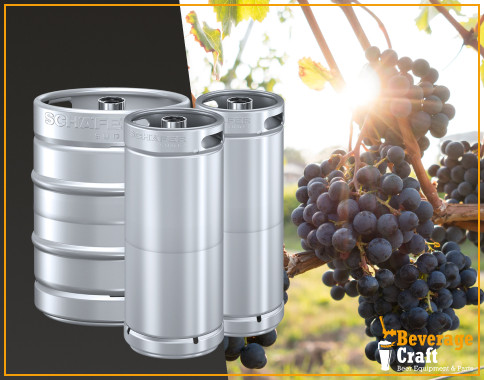Wine Kegs Guide and Important Things to Know
Posted by Ron on 5th Jul 2021
If there’s one myth to be debunked about wine from a wine keg it’s that it’s low-quality. Nothing could be further from the truth. In fact, draught wine has become more popular since people started to realize the pros of wine on tap.
Here we’ll talk all about draught wine and the kegs that are used to dispense it. Let’s start with the basics and see what’s great and not so great about wine kegs.
Wine Kegs Pros and Cons
Here are some pros and cons of kegging wine and using wine kegs for you to consider.
Pros
- You get more consistent wine
Less distance to travel from keg to tap means less chance of wine losing its taste due to oxidization, broken bottle, etc. - You get less waste and more savings
Kegged wine is simply cheaper than the same wine in a bottle. Something to think about if you’re a restaurant owner, isn’t it? - It’s eco-friendly
If you want to be easier on the environment, this is a great step.
Cons
- Wine kegs require proper and regular maintenance
Although it’s not very challenging, it does take up some time and resources. - You get fewer wine options
Unfortunately, not every winery is keen on producing kegged wine, so your choices are limited. - You might have to deal with elitist wine drinkers
Some people simply detest the very idea of drinking wine from a stainless-steel wine keg, and they will be sure to let you know about it.
Comparing Wine Keg Sizes & Types
When it comes to wine keg sizes and wine keg volume, they are practically the same as beer keg sizes. There are two distinct varieties of kegs – an industry-grade Sanke keg, mostly used by breweries, and a Corny (Cornelius) keg favored by home winemakers.
Here is a table with the most commonly used wine keg sizes.
| Keg type | Capacity (gal/oz) | Height (inches) | Weight (lbs) | Width (inches) |
| Mini keg | 1.32 / 169 | 9⅞ | 13 | 6¾ |
| Sixth barrel | 5.16 / 661 | 23⅜” | 58 | 9¼ |
| Quarter barrel | 7.75 / 992 | 13⅞” | 87 | 16⅛ |
| Slim quarter | 7.75 / 992 | 23⅜” | 87 | 11⅛ |
| Half barrel | 15.5 / 1984 | 23⅜ | 161 | 16⅛ |
| Cornelius Keg | 5.0 / 640 | 23 | 49 | 9 |
Wine Kegs Settings and Components
The basic setup for a wine keg system consists of nearly the same components as a draught beer dispensing system, albeit with subtle nuances. Here are the basic elements:
- Gas tank
- Gas regulator
- Beverage line
- Gas line
- Gas disconnect
- Beverage disconnect
- Keg (as a rule, 5-gallon Corny keg)
- Tap/faucet
The gas you need to use depends on the type of wine you’re planning to dispense. If it’s a still wine, then you have to go with argon or nitrogen (a less expensive option). Kegging wine with CO2 is suitable if you’re planning to serve sparkling wine.
If you’re wondering how to keg wine, here’s a brief, step-by-step description of the process. Take a keg that’s been previously cleaned and sanitized (more on that below), siphon the wine into it, and close the lid.
Purge the headspace to get rid of the oxygen that’s still in the keg and replace it with the gas of our choice. To do so, hook up the gas disconnect to the keg and turn on the gas setting the pressure to 10 PSI.
The gas will hiss into the keg - when the hissing stops, turn the gas off and pull the pressure release valve. This will vent out the gas and stop in a few moments. Repeat the process 3-6 times before finally letting some gas into the keg to blanket the wine. Now it’s ready for dispensing.
How to Store and Clean Wine Kegs
Much like wine bottles, wine kegs should be stored in dry, chilled environments and protected from direct sunlight. If you have to store your keg wine under the counter, make sure the ambient temperature does not exceed 220 C (720 F).
As for the wine and keg cleaning, it’s not much different from beer keg cleaning - here’s an article that covers this topic in-depth. Ideally, you should clean your wine keg and beverage lines at least once a month (or even once every two weeks, depending on how frequently you use it).
Disassemble the system and use a keg cleaning solution to get rid of any sediments or other types of organic stains that tend to build up inside your beverage lines and on the keg walls and bottom. Do not forget to rinse your keg thoroughly after cleaning and purge it before filling it with wine again.
Wine Keg Prices and Where to Buy It?
If you’re looking where to buy a wine keg for your restaurant or home bar, look no further than BeverageCraft. Of all the keg wine distributors, our company is your top choice because we offer high-quality, affordable wine kegs, keg parts, and other keg equipment in Canada and the USA. We ship products all across North America always offering the best deals to our clients.
Our wine keg prices are highly competitive, and our product range is wide enough for you to find a wine keg of the right size, capacity and style. Feel free to browse our selection and let us know if you have any questions - we’ll be there to help.


